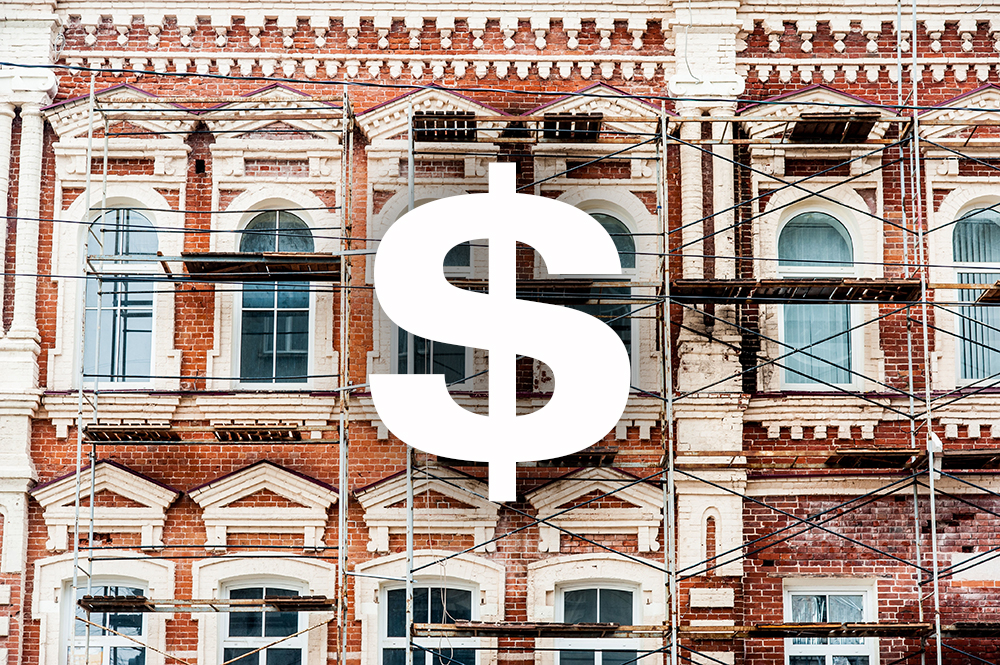Three Types of Funding for Historic Renovations: Part 1 – Historic Tax Credits

In this series of blog posts, we’ll explore different ways of finding money for your renovation project. This week we’ll begin with Historic Tax Credits.
If you know where to look, there are a lot of funding options available for your historic renovation project. Here are three different types of funding that can help get your project on track.
Three Different Types of Historic Renovation Funding
1. Historic Tax Credits
2. Grants
3. Utility Rebates
Historic Tax Credits
Federal and state Historic Tax Credit programs (HTC’s) are a great resource for historic renovation funding. A project meeting the standards can receive a Federal Tax credit of 20% of eligible costs plus state credits of varying amounts. For example, Maryland has several programs with 20% credits and Virginia’s program has a credit of 25%. Other HTC programs are run by local governments, such as Baltimore and Prince George’s County.
The Federal HTC program is administered by the National Park Service (NPS) and the Internal Revenue Service (IRS) and helps provide funding by encouraging the private sector to invest in the rehabilitation of historic buildings. Since the Tax Reform Act of 1976, this program has helped aid in the rehabilitation of over 42,000 certified historic buildings. The state programs are typically run by the State Historic Preservation Officer (SHPO).
The Types Of Buildings That Are Eligible For Historic Tax Credits

According to the National Parks Service , one of the administrators of the Historic Tax Credit program, in order to qualify for this federal tax program, the rehabilitation project must meet these four requirements:
1. The historic building must be listed or determined eligible for listing in the National Register of Historic Places or be certified as contributing to the significance of a “registered historic district.”
2. The project must meet the “substantial rehabilitation test.”
3. The rehabilitation work must be done according to the Secretary of the Interior’s Standards for Rehabilitation.
4. After rehabilitation, the historic building must be used for an income-producing purpose for at least five years.
To learn more about each of these requirements, visit the National Park Service ’s Eligibility Requirements page.
Historic tax credits allow participants to claim 20% of eligible improvement expenses. The National Park Service’s list of eligible expenses includes:
- Walls
- Partitions
- Floors
- Ceilings
- Permanent coverings
- Windows
- Doors
- Central air conditioning
- Heating systems
- Plumbing and plumbing fixtures
- Electrical wiring
- Lighting fixtures
- Chimneys
- Stairs
- Escalators and elevators
- Sprinkler systems
- Fire escapes
One great aspect of the Historic Tax Credit program, is that in addition to being offered at the federal level, it is sometimes offered at both the state and local level as well. So, if your state offers it, you or your private sector investor could claim another 20% or 25%. And, if it’s available in your county, too, that’s an additional 20%.
States That Offer Historic Tax Credits
As of right now, 36 states offer historic tax credits for historic building renovations/ rehabilitation. And, some of these states even offer more than one program. Additionally, both Tennessee and Michigan are currently working on putting these tax credit programs into place. Here is a list of the different state programs currently available:
- Alabama Historic Rehabilitation Tax Credit
- Arkansas Historic Rehabilitation Income Tax Credit
- Colorado Job Creation Main Street Revitalization Act
- Connecticut State Historic Rehabilitation Tax Credit
- Connecticut Historic Structures Rehabilitation Tax Credit
- Delaware Historic Preservation Tax Credit Program
- Georgia Income Tax Credit Program for Rehabilitated Historic Property Program
- Indiana’s Residential Historic Rehabilitation Credit
- Illinois Historic Preservation Tax Credit Program
- Illinois’s Bicentennial Mississippi River Region Redevelopment Historic Tax Credit Act
- Iowa Historic Preservation and Cultural & Entertainment District Tax Credit Program
- Kansas Historic Rehabilitation Tax Credit Program
- Kentucky Historic Preservation Tax Credit Program
- Louisiana Commercial Tax Credit Program
- Maine State Rehabilitation Tax Credit
- Maryland Heritage Structure Rehabilitation Tax Credit Program
- Massachusetts Historic Rehabilitation Tax Credit Program
- Minnesota Historic Structure Rehabilitation Tax Credit
- Mississippi Historic Tax Credit
- Missouri Historic Tax Credits
- Montana Historic Rehabilitation Income Tax Credit Program
- Nebraska Job Creation and Mainstreet Revitalization Act
- New Mexico Income Tax Credit for Registered Cultural Properties Program
- New York Rehabilitation Tax Credit for Commercial Properties
- New York Historic Barn Rehabilitation Tax Credit
- New York Historic Homeownership Rehabilitation Tax Credit
- North Carolina Credit for Rehabilitating Income-Producing Historic Structure
- North Carolina Historic Preservation State Tax Credits for Non-Income Producing Properties
- North Dakota Renaissance Zone Rehabilitation Tax Credit
- Ohio Historic Preservation Tax Credit
- Oklahoma Investment Tax Credits for Rehabilitation
- Pennsylvania Historic Preservation Incentive Tax Credit Program
- Rhode Island Historic Preservation Tax Credit Program
- South Carolina Historic Rehabilitation Tax Credit Program
- South Carolina Textiles Communities Revitalization Tax Credit Program
- Texas Historic Preservation Tax Credit Program
- Utah Historic Preservation Tax Credit Program
- Vermont Downtown and Village Tax Credit
- Virginia Rehabilitation Tax Credits
- West Virginia Historic Rehabilitation Tax Credit Program
- Wisconsin Historic Preservation and Rehabilitated Tax Credit Program
Not sure where to begin or how to pursue Historic Tax Credits? Encore is happy to help. Tell us about your project.
Next we’ll cover grants as a source for funding your historic renovation.
